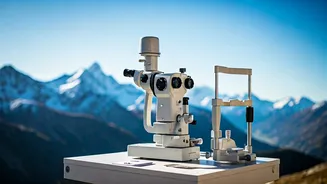Initial Vision Loss
An eye surgeon brought attention to a peculiar case involving a 19-year-old individual who encountered a sudden loss of sight in their right eye while
hiking at a significant altitude of 15,000 feet. This specific instance falls under the umbrella of high-altitude retinopathy, a rare condition tied to the physiological strains of elevated surroundings. The individual's experience serves as a powerful illustration of how the conditions in high altitudes can uniquely impact the body. This includes potential effects on the eyes, offering important learning opportunities for those who enjoy the sport of mountaineering and other high-altitude experiences.
Understanding Retinopathy
Retinopathy, in a broad sense, refers to any damage to the retina, which is the light-sensitive tissue at the back of the eye. Different factors may result in retinopathy, each having unique effects on vision. High-altitude retinopathy specifically relates to damage caused by the conditions in high-altitude environments. At these heights, reduced oxygen levels and lower atmospheric pressure can stress the body. The decreased oxygen supply can lead to physiological changes that may manifest in the eyes. Understanding the underlying mechanisms is essential in both preventive measures and ensuring proper care in high-altitude scenarios.
Altitude’s Impact
As one ascends to higher altitudes, there is a substantial reduction in the partial pressure of oxygen. This leads to what is commonly known as hypoxia, a condition characterized by oxygen deprivation in the body's tissues. The retina is particularly susceptible to hypoxia, due to its high metabolic rate and oxygen needs. The circulatory system also deals with elevated pressure differences and lower oxygen concentrations. These factors combine to heighten the risk of visual disturbances. They also lead to more serious and lasting damage. These effects underscore the importance of understanding and preparing for the physiological challenges presented by high-altitude environments.
Symptoms & Effects
The symptoms of high-altitude retinopathy can manifest in various ways. These symptoms may include blurred vision, spots, or floaters in the field of vision. More severe instances can lead to retinal hemorrhages, swelling, and even potential vision loss. These symptoms generally come from the impact of altitude on the eye's blood vessels. It is important to realize the effects of high-altitude retinopathy are not universal. The severity varies among individuals. These differences are influenced by factors like acclimatization to the altitude and the duration of exposure. Early identification of symptoms, along with prompt medical attention, is critical for mitigating damage and supporting vision preservation.
Risk Factors Involved
Several factors can increase the probability of high-altitude retinopathy. Going to high altitudes too rapidly without proper acclimatization is one of the biggest risks. Other risk factors include pre-existing medical conditions, especially those affecting the circulatory system. This may include diabetes and hypertension, which already weaken blood vessels. The duration of time spent at high altitudes also plays a role, with longer exposures increasing the risk. Furthermore, certain individual factors such as age and overall health can also affect susceptibility to the condition. Understanding these risk factors enables climbers and trekkers to make informed decisions about planning and safety.
Prevention & Safety
Preventing high-altitude retinopathy primarily centers around gradual acclimatization to the altitude. This approach allows the body to adjust gradually to lower oxygen levels. The ascent should be slow. This will help reduce the strain on the eyes and other body systems. Staying well-hydrated and avoiding strenuous activity during the initial days at high altitudes can also minimize risks. Individuals with pre-existing health conditions should seek medical advice before planning high-altitude excursions. Regular eye examinations are crucial. These actions, combined with early recognition of symptoms, are critical to ensuring both safety and enjoyment in high-altitude environments.











